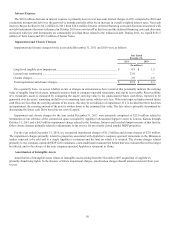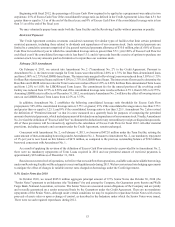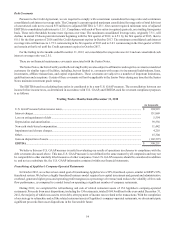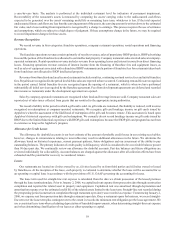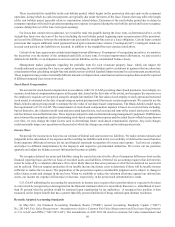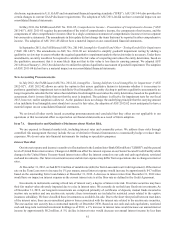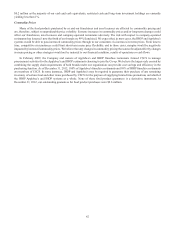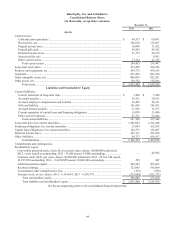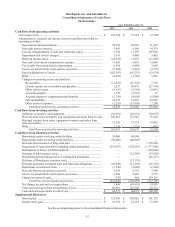IHOP 2012 Annual Report Download - page 76
Download and view the complete annual report
Please find page 76 of the 2012 IHOP annual report below. You can navigate through the pages in the report by either clicking on the pages listed below, or by using the keyword search tool below to find specific information within the annual report.58
Critical Accounting Policies and Estimates
The preparation of financial statements in accordance with U.S. GAAP requires us to make estimates and assumptions that
affect the reported amounts of assets and liabilities at the date of the financial statements and the reported amounts of net revenues
and expenses in the reporting period. We base our estimates and assumptions on current facts, historical experience and various
other factors that we believe to be reasonable under the circumstances, the results of which form the basis for making judgments
about the carrying values of assets and liabilities and the accrual of costs and expenses that are not readily apparent from other
sources. Accounting assumptions and estimates are inherently uncertain and actual results may differ materially from our estimates.
We believe the following critical accounting policies require us to make significant judgments and estimates in the preparation
of our consolidated financial statements:
Goodwill and Intangibles
Goodwill is recorded when the aggregate purchase price of an acquisition exceeds the estimated fair value of the net identified
tangible and intangible assets acquired. Intangible assets resulting from the acquisition are accounted for using the purchase method
of accounting and are estimated by management based on the fair value of the assets received. Identifiable intangible assets are
comprised primarily of trademarks, tradenames and franchise agreements. Identifiable intangible assets with finite lives (franchise
agreements, recipes, menus and favorable leaseholds) are amortized over the period of estimated benefit using the straight-line
method and estimated useful lives. Goodwill and intangible assets considered to have an indefinite life (primarily tradename and
liquor licenses) are not subject to amortization. The determination of indefinite life is subject to reassessment if changes in facts
and circumstances indicate the period of benefit has become finite.
Goodwill has been allocated to three reporting units, the Applebee's company-operated restaurants unit ("Applebee's company
unit"), the Applebee's franchised restaurants unit ("Applebee's franchise unit") and the IHOP franchised restaurants unit ("IHOP
franchise unit"), in accordance with U.S. GAAP. The significant majority of our goodwill resulted from the November 29, 2007
acquisition of Applebee's and was allocated between the two Applebee's units. The goodwill allocated to the Applebee's company
unit was fully impaired in 2008.
We have elected to bypass the option allowed under U.S. GAAP to perform a qualitative assessment of goodwill and other
indefinite life intangible assets for impairment. We perform a quantitative test for impairment on an annual basis. The impairment
test of goodwill of the Applebee's franchise unit and the tradename of the Applebee's company and franchise units is performed
as of October 31 of each year. The impairment test of the goodwill of the IHOP franchise unit is performed as of December 31 of
each year. In addition to the annual test of impairment, goodwill and indefinite life intangible assets are evaluated more frequently
if we believe indicators of impairment exist. Such indicators include, but are not limited to, events or circumstances such as a
significant adverse change in the business climate, unanticipated competition, a loss of key personnel, adverse legal or regulatory
developments or a significant decline in the market price of our common stock.
In the process of our annual impairment review of goodwill, we primarily use the income approach method of valuation that
includes the discounted cash flow method as well as other generally accepted valuation methodologies to determine the fair value
of goodwill and intangible assets. Significant assumptions used to determine fair value under the discounted cash flows model
include future trends in sales, operating expenses, overhead expenses, depreciation, capital expenditures and changes in working
capital, along with an appropriate discount rate based on our estimated cost of equity capital and after-tax cost of debt. The first
step of the quantitative impairment test compares the fair value of each of our reporting units to their carrying value. If the fair
value is in excess of the carrying value, no impairment exists. If the first step does indicate an impairment, a second step must
take place. Under the second step, the fair value of the assets and liabilities of the reporting unit are estimated as if the reporting
unit were acquired in a business combination. The excess of the fair value of the reporting unit over the amounts assigned to its
assets and liabilities is the implied fair value of the goodwill, to which the carrying value of the goodwill must be adjusted. The
fair value of all reporting units is then compared to the current market value of our common stock to determine if the fair values
estimated in the impairment testing process are reasonable in light of the current market value.
In the process of our annual impairment review of the tradename, the most significant indefinite life intangible asset, we
primarily use the relief of royalty method under income approach method of valuation. Significant assumptions used to determine
fair value under the relief of royalty method include future trends in sales, a royalty rate and a discount rate to be applied to the
forecast revenue stream.
Long-Lived Assets
We assess long-lived and intangible assets with finite lives for impairment when events or changes in circumstances indicate
that the carrying value of the assets may not be recoverable. We test impairment using historical cash flows and other relevant
facts and circumstances as the primary basis for our estimates of future cash flows. We consider factors such as the number of
years the restaurant has been operated by us, sales trends, cash flow trends, remaining lease life, and other factors which apply on




